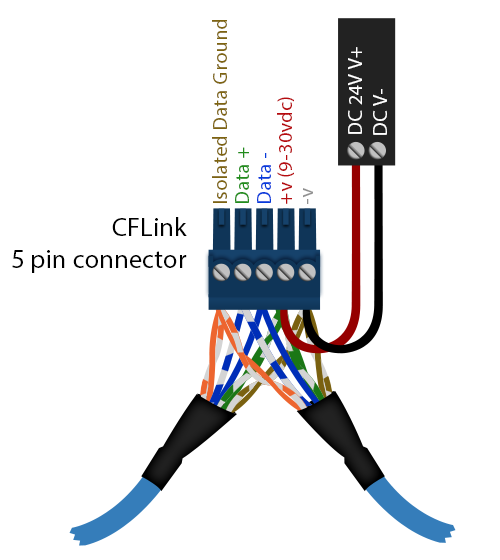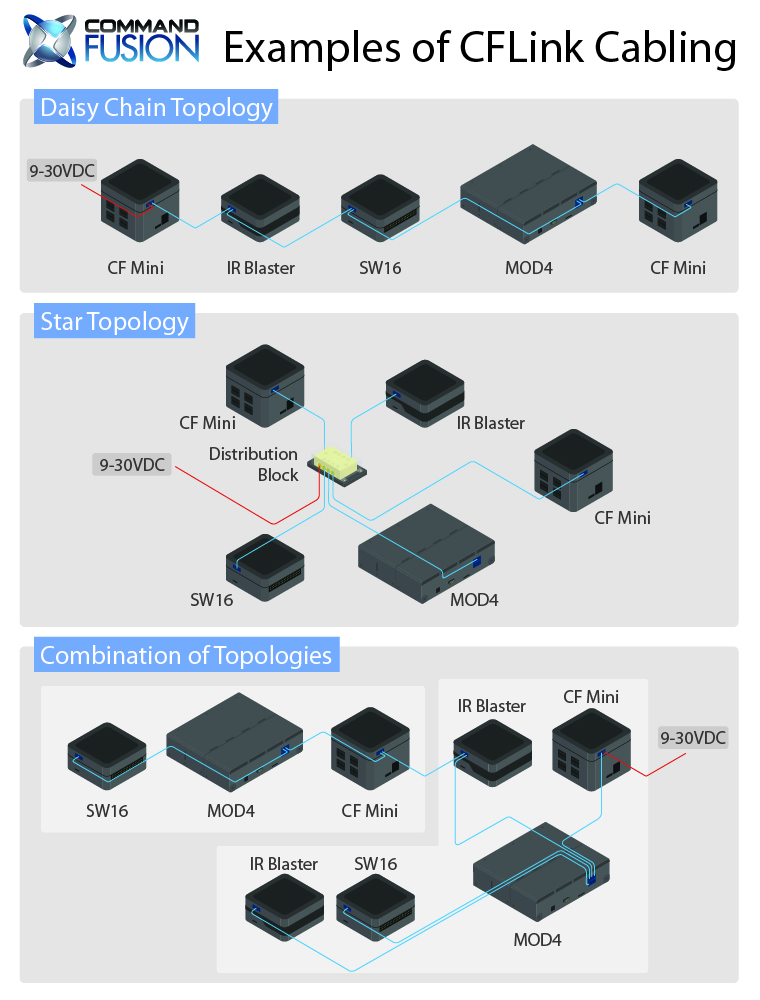Table of Contents
CFLink Overview - Why Choose CFLink?
Since the release of our initial hardware lineup in May of 2012, one of the most common questions we get is “Why did you create CFLink when Ethernet already exists?”
While the easy method was to go with the crowd, and implement an IP based communications method – we didn’t believe it was the right choice. We chose to go with CFLink based on our experience in the industry, after extensive R&D and after talking to integrators about what they look for when choosing control hardware.
What is CFLink?
Firstly, lets take a look at what CFLink actually is. CFLink is a 5-wire RS485 bus that carries both power and data to devices over a maximum distance of 1.6 kilometers. Up to 238 devices can exist on a single network, and multiple CFLink networks can communicate with each other via Ethernet, providing an endlessly scalable system.
CFLink can run on any cable with 5 or more cores, including CAT5/6 and 2-pair shielded cable. When using CAT5/6, you should use one pair for voltage + and one pair for voltage - to decrease the voltage drop over longer runs.

CFLink can use any wiring topology, including daisy chaining between devices or home runs. Most existing systems use a master-slave approach on their bus, but CFLink is a true Peer to Peer bus, where each device is an equal. This distributed intelligence results in a more reliable system because each unit remains fully functional even if one of the devices drops off the network whereas a master-slave system is completely down when the master is down.
CFLink v Standard RS485
Power Requirements
Existing powered 4-pin RS485 buses have some common issues which CFLink overcomes. The first is a fixed voltage requirement which results in a low tolerance for voltage drops over longer cable distances. CFLink operates from 9-30v DC with low power consumption resulting in exceptional tolerance for long cable runs without adding more power supplies.
The second is the addition of a 5th isolated ground for data to prevent interference from ground loops in large scale projects.
Peer to Peer Bus
Without a master, CFLink will continue to function even if multiple devices fail since each device stores its own relevant logic processing.
Device ID Conflict Resolution
Each device on the CFLink bus must have a unique ID. Each product model will ship with a specific ID from the factory. So when you first connect multiple devices of the same model name onto the bus, they will share the same ID, which causes an ID conflict. Other automation systems require you to manually set each device ID uniquely, whilst only powering one device up at a time, which wastes precious time and resources. Furthermore, if a device ID conflict exists in such systems, it is not even reported which leads to malfunction and headaches. CommandFusion hardware supports automatic ID conflict resolution. So with the click of a button, all ID conflicts will be resolved, without having to disconnect any device from the network. This is a great time saver, especially for larger systems and allows for installation of hardware onsite without first having to configure the ID’s of CFLink devices.
Incorrect Cabling Tolerance
CFLink devices are built to be tolerant of incorrect cabling. If for some reason a CFLink port is wired incorrectly, it will not cause damage. The incorrect wiring can be rectified and the hardware will operate as expected.
CFLink vs Ethernet
Ethernet is a great communications method, however in reality it causes many problems in automation and is not always the best solution. There are many reasons to choose CFLink for your next system.
Flexible Cabling and Topology
The wiring topology is very flexible. Ethernet would require each device to be wired back to a switch or hub, whereas CFLink can loop from device to device. Almost any cable configuration you can imagine is supported e.g. a mix of star, and daisy topology works fine.

Cable Type
CFLink can use almost any cable as long as it has 5 wires (or 4 wires and shield, or even just 4 wires if that is the only available option). Ethernet is limited to particular cables – Cat5/6, etc. This has obvious advantages for retrofitting.
Easier to Manage
Ethernet introduces many management and configuration issues such as IP conflicts, correct subnets, VLAN routing, DHCP server settings, and the list goes on and on. In the perfect world, Ethernet networks are stable. But introduce unknowns such as end users plugging in their own computers and connecting mobile devices, and networks can quickly become a nightmare to keep reliably running without interruption. CFLink runs independently of the Ethernet network, so communication between devices remains reliable without needing to worry about external factors.
Longer cable runs
Ethernet can only run 100m on standard cabling, whereas CFLink can run in excess of 1.5 kilometers without repeaters, optical fibre cabling or other extenders.
Less Traffic
Ethernet networks are inherently busy with communication traffic - especially with the introduction “noisy” devices like media streamers, live IP cameras and the proliferation of mobile devices with our constant need to stay connected. With general networking usage, a slow or interrupted network request is no big deal - maybe the web page just needs to be refreshed. But in a control and automation environment, missed commands or slow reply processing can be extremely frustrating. Keeping the control network completely separate from traditional data networks bypasses this problem and provides a much more reliable automation system.
Cost Effectiveness of Power and Data Over a Single Cable
Whilst PoE exists, the equipment required is still extremely expensive compared to normal Ethernet or CFLink.
Cost
This section has 2 parts, the first is the cost of the hardware itself. If we added an Ethernet port to every piece of hardware, it would not be as cheap as it is today – hence losing some of its attractiveness in the marketplace. The second part is the cost of the infrastructure to run an Ethernet network. Sure, it’s not that expensive to buy a basic 4, or even 8 port switch. But when you start talking about larger numbers of devices, even in a home - the cost of installing and maintaining a reliable network is huge. All devices require a dedicated cable to be run to a switch, which is not merely expensive but it can also be messy. A cost benefit analysis would show that Ethernet is typically much more expensive in both the short and the long term when compared with CFLink.
Wi-Fi
Any sort of wireless technology is less reliable than a wired system. This is increasingly the case with more and more wireless systems installed, leading to increased dropouts, system failures and endless frustration. A new router purchased by a neighbour could cripple your entire system.
Wireless place for convenience, but hard-wired systems should always be the first choice for reliable automation. Wireless communication relies on networking hardware that is vulnerable to failures, a simple failure on your router would result in the entire home automation system to be offline.
So Why Should You Choose CFLink?
Obviously all communications technologies have their advantages and disadvantages. To make the right decision you need make an informed choice.
Ethernet and Wifi has its place with media servers, wireless tablets and phones and the list goes on, but in the world of control, Ethernet should be the gateway to control automation rather than the infrastructure used.
In summary, this is why we think that CFLink is a better choice:
- Lower cabling cost
- Easier to manage
- Large network size
- Extra long cable runs viable (up to 1.6km)
- Flexible, efficient and cost effective power requirements
- Low maintenance
- High reliability
To see application diagrams for CommandFusion Hardware, see this page.